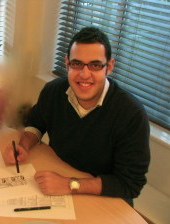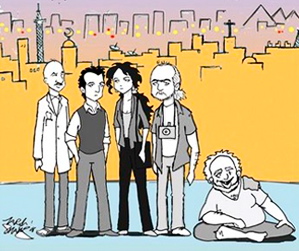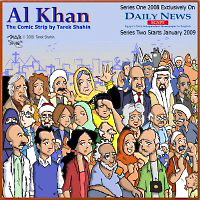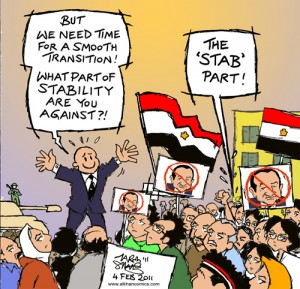Note: An INTERVIEW with the author follows this review.
“You still miss London?”
“What do I always say, Nada? Egypt is my lady, Cairo’s my little girl. You know, with the adorable features and the curious baby steps…and the constant shouting and screaming!”—Omar Shukri, young publisher of Al Khan.
Cairo-born cartoonist Tarek Shahin, who counts Garry Trudeau as one of his idols, reveals many of the same insightful, irreverent, and humorous attitudes toward life in this collection of his own cartoons as Trudeau has shown in Doonesbury during his long career. Published every day, from April, 2008, through April, 2010, in the Daily Star, Egypt’s independent English language newspaper, Shahin’s “Al Khan” cartoons foreshadowed the popular revolution which eventually took place in Tahrir Square between January 25 and February 11, 2011. Using daily life and newsworthy events, both social and political, as his inspiration, Shahin provides an unforgettable vision of what life was like in Cairo in the months leading up to the revolution. For a western reader like myself, who saw the revolution from a distance and may have regarded it as a bit of a surprise, Shahin’s cartoons make this momentous event much more personal, immediate, dramatic, and most of all, understandable because the forces leading up to it, along with its full, lasting impact, can be connected with “real” people, even though those “real” people are cartoon characters.
from April, 2008, through April, 2010, in the Daily Star, Egypt’s independent English language newspaper, Shahin’s “Al Khan” cartoons foreshadowed the popular revolution which eventually took place in Tahrir Square between January 25 and February 11, 2011. Using daily life and newsworthy events, both social and political, as his inspiration, Shahin provides an unforgettable vision of what life was like in Cairo in the months leading up to the revolution. For a western reader like myself, who saw the revolution from a distance and may have regarded it as a bit of a surprise, Shahin’s cartoons make this momentous event much more personal, immediate, dramatic, and most of all, understandable because the forces leading up to it, along with its full, lasting impact, can be connected with “real” people, even though those “real” people are cartoon characters.
Shahin’s five main characters reflect both their unique personalities and the various points of view which may be found in the vibrant cityscape of Cairo, and as they interact with each other, their lives become a microcosm of much wider forces at work. Main character Omar Shukri has been working in London when he is called back to take over as publisher of his grandfather’s magazine, “Al Khan,” an appointment which is not met with universal delight among the staff. Nada Saleh, a reporter whom the grandfather has appointed editor-in-chief of the magazine, plans to emphasize socially liberal causes, and she frequently finds herself nose to nose with Omar, who, though a “liberal capitalist,” is far more pragmatic than she is. Dr. Anwar Abutaleb, a devout Muslim and general practitioner with a large but not lucrative practice, is a friend who often shares “shisha” with Omar, though Omar regards him as extremely conservative. Because of his job, however, Anwar sees the accidents of history in ways different from other characters and often provides unusual insights.
back to take over as publisher of his grandfather’s magazine, “Al Khan,” an appointment which is not met with universal delight among the staff. Nada Saleh, a reporter whom the grandfather has appointed editor-in-chief of the magazine, plans to emphasize socially liberal causes, and she frequently finds herself nose to nose with Omar, who, though a “liberal capitalist,” is far more pragmatic than she is. Dr. Anwar Abutaleb, a devout Muslim and general practitioner with a large but not lucrative practice, is a friend who often shares “shisha” with Omar, though Omar regards him as extremely conservative. Because of his job, however, Anwar sees the accidents of history in ways different from other characters and often provides unusual insights.
Yunan Saliba, one of the most charming of the characters, is an award-winning photographer, just past forty, who still lives at home with his Coptic parents, who are desperate to marry him off. The Big Falafel, a street beggar, has, for years, provided Nada with news tips and information which he is able to obtain because he is essentially “invisible” to society. Obviously extremely intelligent, the Big Falafel is a mystery, causing the reader to wonder about the circumstances under which he ended up a beggar.
 Wonderful peripheral characters also provide unique glimpses of Cairo life. Anwar’s wife Aisha wears both the hijab and the niqab, covering all but her eyes, and her face is never shown, blurred out even in those cartoons which take place in her home with Anwar. Noah Levy, a Jewish exchange student from England, comes to study in Cairo and becomes a close friend of Anwar, who does not realize that Noah is Jewish, leading to some “interesting” conversations. Jane, Omar’s ex-girlfriend from London, and (hilariously clueless) Dr. Ebaa Antar, an American sociologist, writing a book about women in the Arab world, round out the list of intriguing characters who appear regularly.
Wonderful peripheral characters also provide unique glimpses of Cairo life. Anwar’s wife Aisha wears both the hijab and the niqab, covering all but her eyes, and her face is never shown, blurred out even in those cartoons which take place in her home with Anwar. Noah Levy, a Jewish exchange student from England, comes to study in Cairo and becomes a close friend of Anwar, who does not realize that Noah is Jewish, leading to some “interesting” conversations. Jane, Omar’s ex-girlfriend from London, and (hilariously clueless) Dr. Ebaa Antar, an American sociologist, writing a book about women in the Arab world, round out the list of intriguing characters who appear regularly.
These characters deal humorously with many topical issues between 2008 and 2010, and though events are fictionalized to the extent that real people are not being mocked, the issues are clearly  delineated. A new Minister of Prosperity, appointed to create structural reform, pledges to “patriotically uphold the status quo.” The issue of privatizing a major engineering company brings out three potential buyers—an Egyptian with suspicious money sources and connections, a woman with a huge and diversified business empire, and a “Gulfie,” from Qatar, with more money than he knows what to do with. The election of Barack Obama, the killing of every pig in Egypt as a “precaution” against swine flu (though no flu was found to exist there), and attacks on Egyptian embassies in Yemen, Lebanon, and Indonesia are other timely issues discussed on the cartoon series.
delineated. A new Minister of Prosperity, appointed to create structural reform, pledges to “patriotically uphold the status quo.” The issue of privatizing a major engineering company brings out three potential buyers—an Egyptian with suspicious money sources and connections, a woman with a huge and diversified business empire, and a “Gulfie,” from Qatar, with more money than he knows what to do with. The election of Barack Obama, the killing of every pig in Egypt as a “precaution” against swine flu (though no flu was found to exist there), and attacks on Egyptian embassies in Yemen, Lebanon, and Indonesia are other timely issues discussed on the cartoon series.
Many sociological issues also come into the spotlight, most of them having to do with the role (or non-role) of women. A female reporter is jailed. Another woman is raped, and no one takes her seriously because she “asked for it”—she was not “covered.’’ The marriage of cousins, the taking of multiple wives, and even genital mutilation in rural villages also become topics here.
 The wonderfully depicted characters, the wry humor and satire, and the concentration on real issues give the reader new insights into life in Cairo just before the Revolution, and the author’s obvious love for the country and its people pervades even the most pointed satire. The conclusion of the series, nine months prior to the revolution, is done with panache, as the author resolves issues in the lives of the characters with whom his readers have spent two years and lets us know the directions he sees them taking. Finely drawn and finely conceived, this visual portrait of Cairo reveals some of the background issues which eventually come to a head on January, 25, 2011. Tarek Shahrir dedicates this book to those eight hundred fifty people who died to make that revolution possible.
The wonderfully depicted characters, the wry humor and satire, and the concentration on real issues give the reader new insights into life in Cairo just before the Revolution, and the author’s obvious love for the country and its people pervades even the most pointed satire. The conclusion of the series, nine months prior to the revolution, is done with panache, as the author resolves issues in the lives of the characters with whom his readers have spent two years and lets us know the directions he sees them taking. Finely drawn and finely conceived, this visual portrait of Cairo reveals some of the background issues which eventually come to a head on January, 25, 2011. Tarek Shahrir dedicates this book to those eight hundred fifty people who died to make that revolution possible.

Images, in order: The author’s photo is from https://sirgoslabyrinth.wordpress.com
The main characters, in order (L-R) are: Dr. Anwar Abutaleb, Omar Shukri (Al Khan’s publisher), Nada Saleh (editor), Yunan Salib (photographer), and the Big Falafel (beggar and tipster for Nada). http://www.menassat.com
The whole cast of characters from Al Khan http://www.facebook.com
Posted on Feb. 4, 2011, one week before Mubarak’s resignation, Shahin depicts an attempt by the government to establish an interim government with Mubarak still in power. http://alkhancomics.com
In this cartoon featuring CNN, Dr. Anwar is working frantically through a disaster, saving dozens of injured children, when he is interrupted by a reporter. Reprinted with permission of Tarek Shahin.
Link to interview with author Tarek Shahin: http://marywhipplereviews.com/interview-with-egyptian-cartoonist-tarek-shahin-creator-of-rise-graphic-novel/
